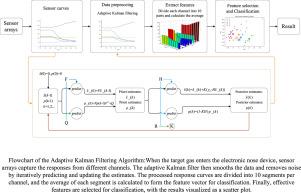基于自适应卡尔曼滤波的电子鼻辅助中药分类
IF 4.9
3区 工程技术
Q2 ENGINEERING, ELECTRICAL & ELECTRONIC
引用次数: 0
摘要
提出了一种基于自适应卡尔曼滤波(Adaptive Kalman Filtering, AKF)的传感器数据预处理方法,以提高电子鼻技术在中药农业种植气味质量监测中的准确性和可靠性。电子鼻装置受到人类嗅觉系统的启发,越来越多地应用于精准农业,在整个种植过程中评估草药的质量和真实性。然而,传统的去噪技术,如移动平均和小波变换,在处理真实农业条件下复杂的动态中药气味数据时存在局限性。为了解决这一挑战,AKF方法动态调整滤波参数,有效降低传感器噪声和漂移,从而显著提高气味数据的稳定性和精度。实验结果表明,与传统的卡尔曼滤波和经典的去噪方法相比,AKF在农业气味分类任务中具有更好的性能。其中,使用支持向量机(SVM)对akf预处理后的数据分类准确率达到95.65%,分别比移动平均和小波变换方法高4.35%和13.04%。将AKF预处理与特征归一化和粒子群优化(PSO)相结合,进一步提高了分类效果。这些发现证明了AKF在中医农业气味检测中的应用潜力,为精准医药农业和草药质量控制提供了重要的理论和实践进展。本文章由计算机程序翻译,如有差异,请以英文原文为准。

E-nose-assisted classification of Traditional Chinese Medicine using Adaptive Kalman Filtering
This study proposes an Adaptive Kalman Filtering (AKF)-based sensor data preprocessing method to enhance the accuracy and reliability of electronic nose (E-nose) technology for odor-based quality monitoring in agricultural cultivation of Traditional Chinese Medicinal (TCM) herbs. E-nose devices, inspired by the human olfactory system, are increasingly applied in precision agriculture to assess the quality and authenticity of medicinal herbs throughout cultivation. However, conventional denoising techniques such as moving average and wavelet transform show limitations when processing complex, dynamic odor data from TCM herbs under real agricultural conditions. To address this challenge, the AKF method dynamically adjusts filtering parameters, effectively reducing sensor noise and drift, thus significantly improving odor data stability and precision. Experimental results confirmed that AKF achieves superior performance in agricultural odor classification tasks compared to conventional Kalman Filtering and classical denoising methods. Specifically, AKF-preprocessed data reached 95.65% classification accuracy using Support Vector Machines (SVM), exceeding moving average and wavelet transform methods by 4.35% and 13.04%, respectively. Integrating AKF preprocessing with feature normalization and Particle Swarm Optimization (PSO) further improved the classification results. These findings demonstrate AKF’s promising application potential in TCM agricultural odor sensing, offering critical theoretical and practical advancements in precision medicinal agriculture and herbal quality control.
求助全文
通过发布文献求助,成功后即可免费获取论文全文。
去求助
来源期刊

Sensors and Actuators A-physical
工程技术-工程:电子与电气
CiteScore
8.10
自引率
6.50%
发文量
630
审稿时长
49 days
期刊介绍:
Sensors and Actuators A: Physical brings together multidisciplinary interests in one journal entirely devoted to disseminating information on all aspects of research and development of solid-state devices for transducing physical signals. Sensors and Actuators A: Physical regularly publishes original papers, letters to the Editors and from time to time invited review articles within the following device areas:
• Fundamentals and Physics, such as: classification of effects, physical effects, measurement theory, modelling of sensors, measurement standards, measurement errors, units and constants, time and frequency measurement. Modeling papers should bring new modeling techniques to the field and be supported by experimental results.
• Materials and their Processing, such as: piezoelectric materials, polymers, metal oxides, III-V and II-VI semiconductors, thick and thin films, optical glass fibres, amorphous, polycrystalline and monocrystalline silicon.
• Optoelectronic sensors, such as: photovoltaic diodes, photoconductors, photodiodes, phototransistors, positron-sensitive photodetectors, optoisolators, photodiode arrays, charge-coupled devices, light-emitting diodes, injection lasers and liquid-crystal displays.
• Mechanical sensors, such as: metallic, thin-film and semiconductor strain gauges, diffused silicon pressure sensors, silicon accelerometers, solid-state displacement transducers, piezo junction devices, piezoelectric field-effect transducers (PiFETs), tunnel-diode strain sensors, surface acoustic wave devices, silicon micromechanical switches, solid-state flow meters and electronic flow controllers.
Etc...
 求助内容:
求助内容: 应助结果提醒方式:
应助结果提醒方式:


